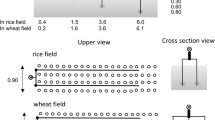Abstract
The restricted volume of wetted soil under trickle irrigation and the depth-width dimensions of this volume are of considerable practical importance. The volume of the wetted soil represents the amount of soil water stored in the root zone, its depth dimension should coincide with the depth of the root system while its width dimension should be related to the spacing between emitters and lines. Thus, the volume and geometry of the wetted soil under an emitter should become an objective rather than an end result of the design process. The purpose of this paper is to introduce and demonstrate an inverse design process, where a management-controlled wetted soil volume, Vm, is estimated first. The parameters which influence the value of Vm are the available water holding capacity of the soil and the peak daily crop water use representing specific field conditions. The irrigation interval and the management-allowed deficit are additional parameters which affect the wetted volume and could be changed depending on crop sensitivity as well as water and irrigation equipment accessibility. A truncated ellipsoid is assumed to best represent the geometry of the wetted soil volume under an emitter. Pairs of possible depth-width dimensions which satisfy the estimated volume of the wetted soil are then computed using the equation of a truncated ellipsoid. Finally, depth-width-discharge combinations which can yield the estimated wetted soil volume are computed using an equation proposed by Schwartzman and Zur (1986). The most suitable combination based on local irrigation practices and available emitters is then selected. Computational examples for three soil types under the same climatic conditions are presented and discussed.
Similar content being viewed by others
References
Amir I, Dag J (1993) Lateral and longtitudial wetting patterns of very low energy moving emitters. Irrig Sci 13:183–187
Benami A, Ofen A (1983) Irrigation engineering. Irrigation Engineering Scientific Publications, Haifa, Israel
Brandt A, Bresler E, Diner N, Ben-Asher J, Heller J, Goldberg D (1971) Infiltration from a trickle source: I. Mathematical models. Proc SSSA 35:675–682
Bresler E (1978) Analysis of trickle irrigation with application design problems. Irrig Sci 1:3–13
Karmeli D, Keller J (1975) Trickle irrigation design. Rain Bird Sprinkler Manufacturing Corporation
Keller J, Bliesner RD (1990) Sprinkler and trickle irrigation. Avi Book, New York
Schwartzman M, Zur B (1986) Emitter spacing and geometry of wetted soil volume. J Irrig Drainage Engr ASCE 112:242–253
Solomon K, Kodama M (1976) Trickle irrigation basic questions and answers from rain bird. Rain Bird Sprinkler Manufacturing Corp
Author information
Authors and Affiliations
Rights and permissions
About this article
Cite this article
Zur, B. Wetted soil volume as a design objective in trickle irrigation. Irrig Sci 16, 101–105 (1996). https://doi.org/10.1007/BF02215617
Received:
Issue Date:
DOI: https://doi.org/10.1007/BF02215617




